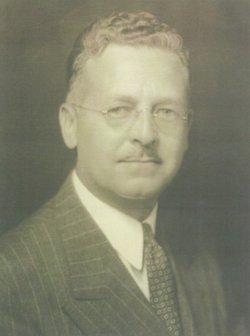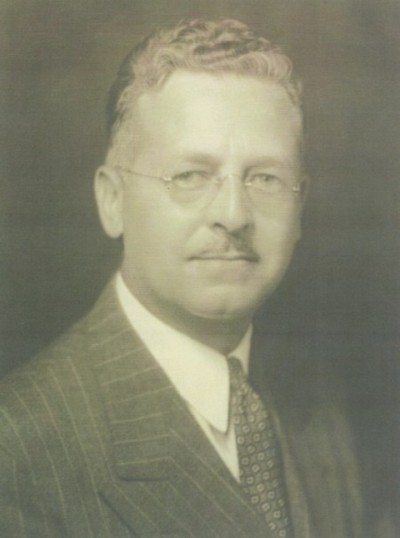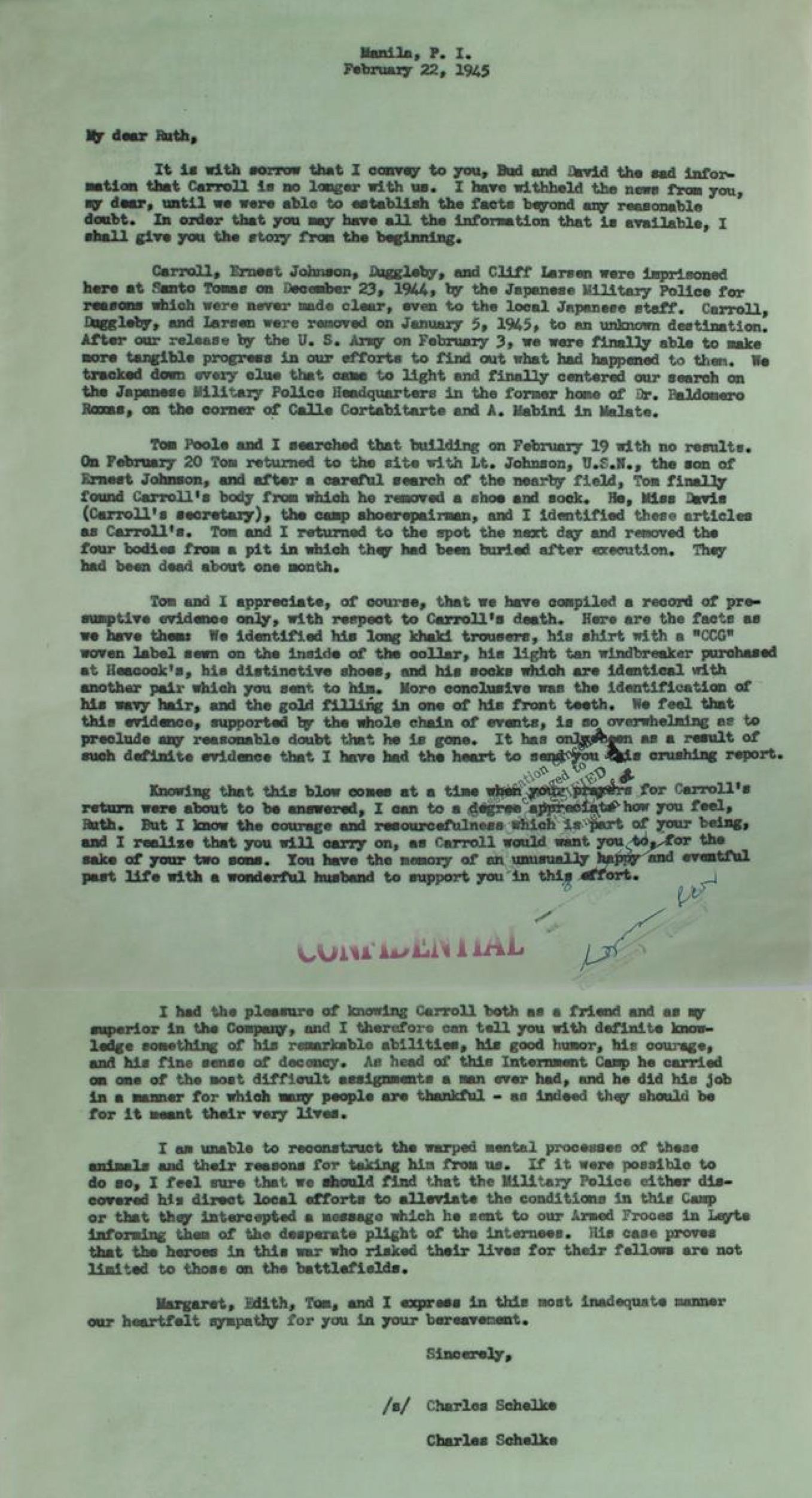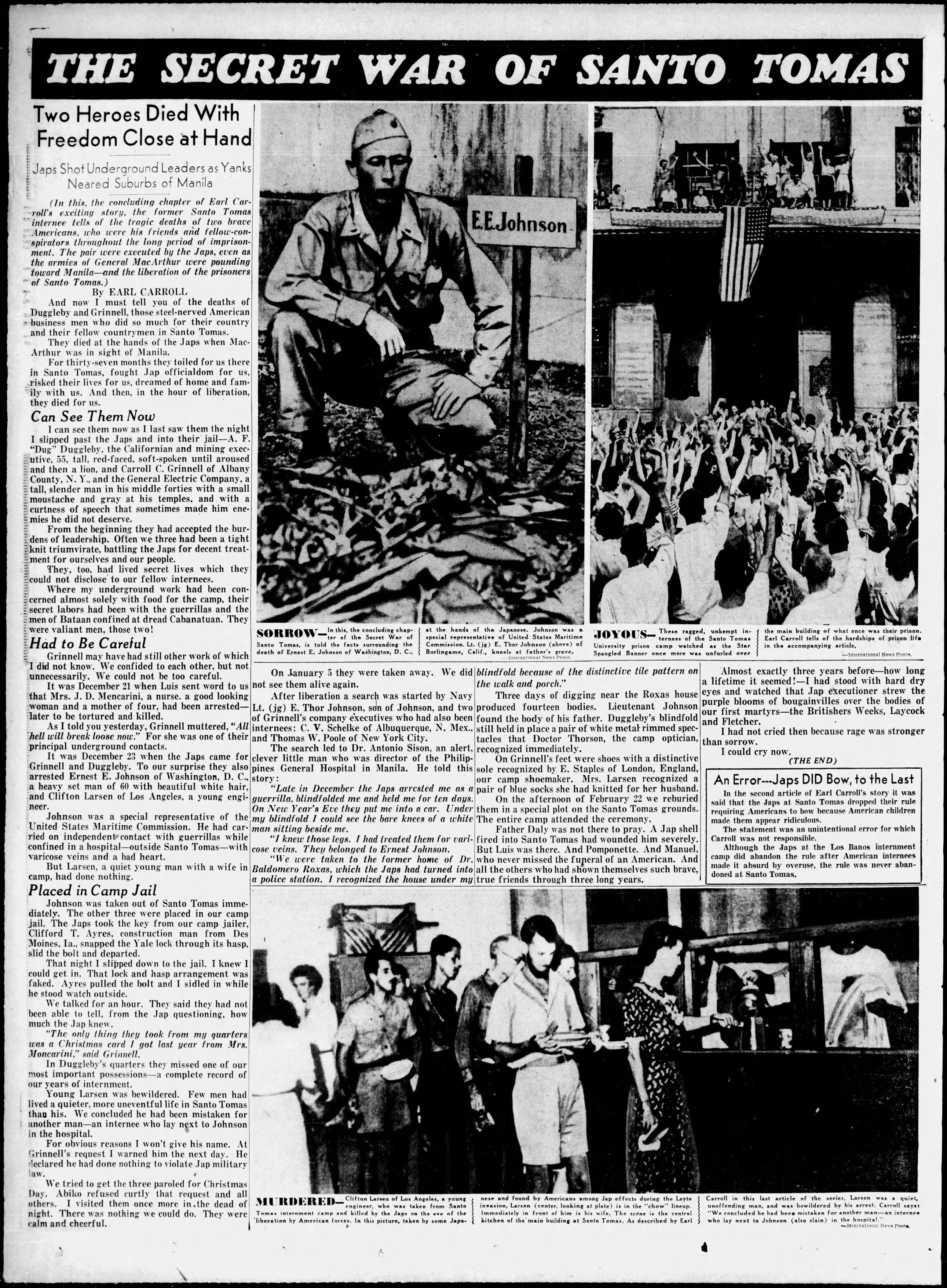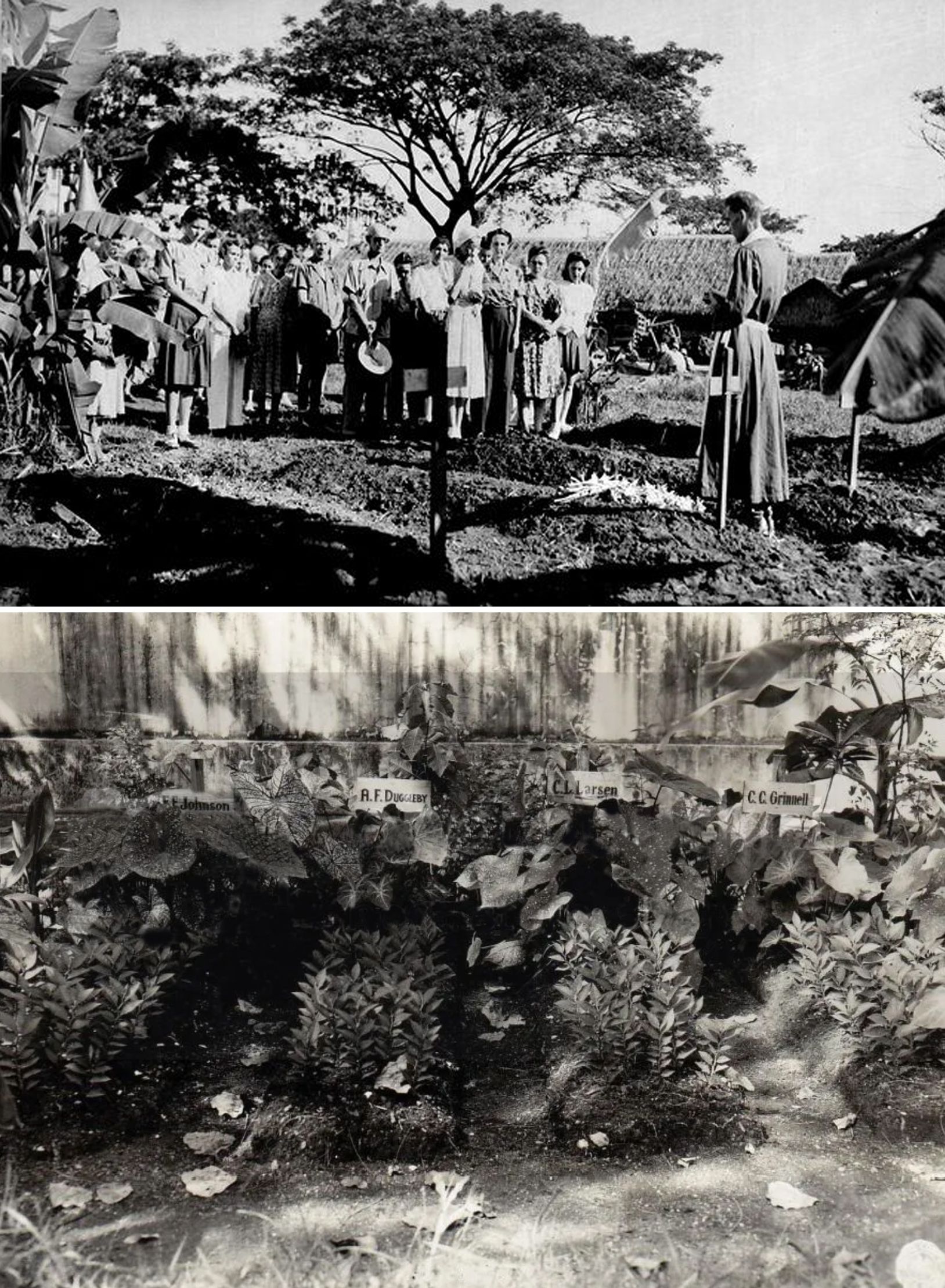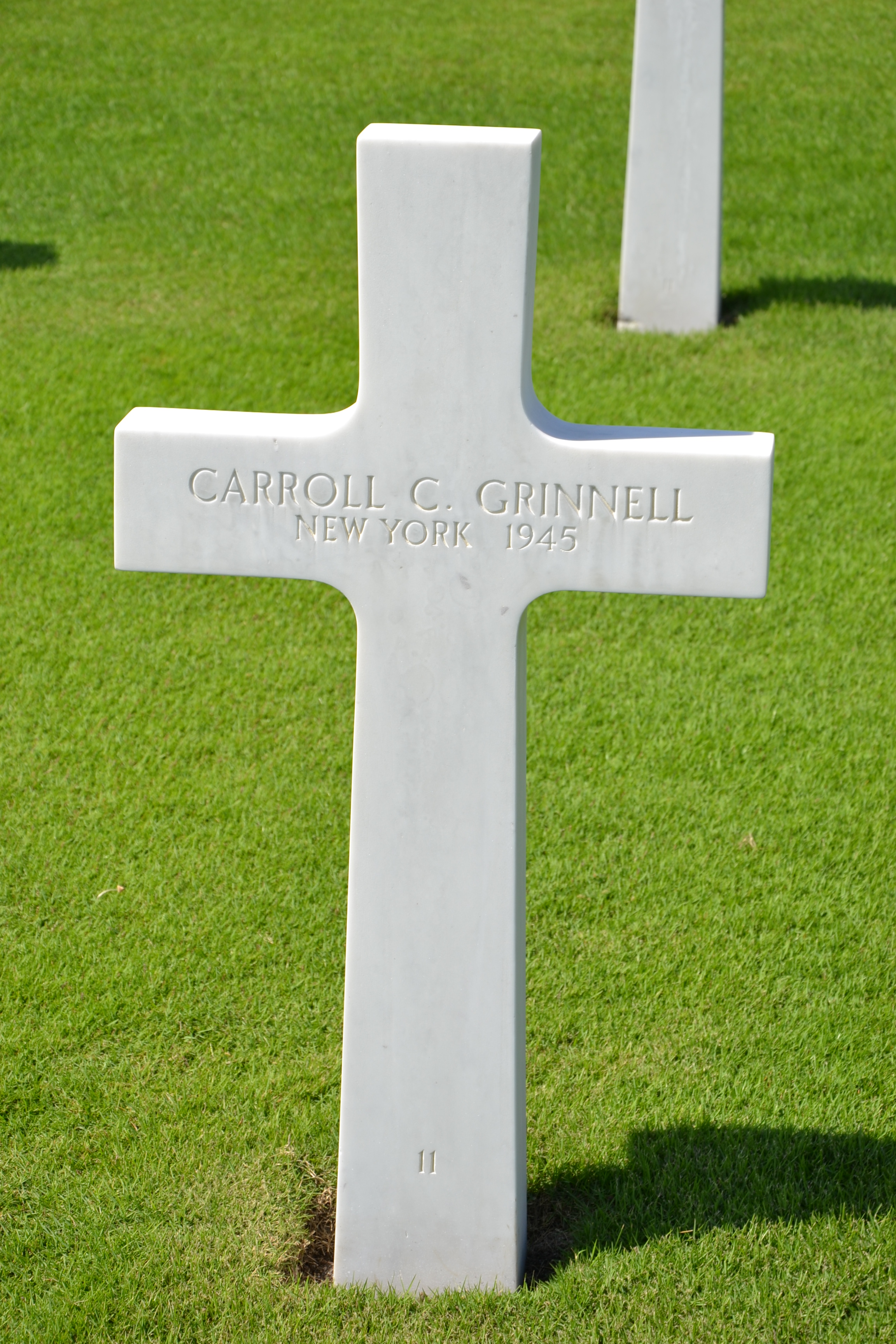He was employed by General Electric in June, 1919 and was sent to Japan in 1923 as an Electrical Engineer. The couple's second son, David Bayldon Grinnell, was born while they were residing in Kobe, Japan. They were there for ten years.
In 1933 he was transferred to Manila, Philippines. In 1940, son, David, was ready to enter 8th grade, so the family returned to the States to enroll him in preparatory school. The State Department would not allow Mrs. Ruth Grinnell to return to Manila with her husband because they felt it was too dangerous as the Japanese Navy was holding maneuvers in the Sea of Japan.
Source: https://cnac.org/emilscott/santotomas01.htm
By the time WWII came to the Philippine shores (08 December 1941), Grinnell was president of General Electric (PI) Inc. and the commercial manager for the Far East. He was scheduled to leave and go back to the United States on the next Pan American Clipper, but it was machine gunned and sunk by the Japanese in the Hong Kong harbor.
On 02 January 1942, Japanese forces entered and occupied Manila and on 07 January 1942, he was detained by Japanese soldiers and sent to the University of Santo Tomas Internment Camp. Carroll became the civilian commandant of the camp which housed more than 3,500 internees at a time from January 1942 until February 1945. A total of about 7,000 people were residents in Santo Tomas at one time or another - 2,000 of which were transferred to the Los Baños internment camp. On 27 July 1942 he was elected to the Executive Committee and the Japanese Commandant (Mr. R. Tsurumi) then appointed Carroll as Chairman of that Committee. "For the past twenty years he had done business in and out of Japan, and his knowledge of things Japanese, including an acquaintance with the language, was of great service to him in his new position." Carroll and the seven-member Executive Committee reported to the Japanese commandant of the camp. He would be the leader of the internees for basically the duration of the war.
23 December 1944 - Santo Tomas Internment Camp
23 December "started ominously for the Camp, when the Commandants staff and guards made a surprise search of Shanty Area B at roll call time...Mr. E. E. Johnson was arrested about 3 p.m. and presumably taken out of Camp for investigation; Mr. C.C. Grinnell, A.F. Duggleby and Clifford I. Larsen were arrested later and held in the Commandant's office until after 7 p.m. when they were lodged in the Camp jail. The shanties of these four internees were thoroughly searched by the military police and soldiers and also Mr. Duggleby's sleeping quarters in the Finance and Supply office. No indication was given as to the reason for their arrests."
"This afternoon about 15 Jap M.P.'s came into camp & tore the place apart – Grinnell, the head of the camp and Duggleleby, one of the camp's leaders were thrown into jail – No one knows why – But I have my suspicions & they center around getting news outside as to the terrible conditions which prevail here – And they are terrible –" Source: Diary of Albert E. Holland, internee
On the night of 23 December, Carroll C. Grinnell, Chairman of the Internees Committee and Alfred F. Duggleby, head of the Family Aid Committee, together with Ernest E. Johnson who works in Grenell's office and a man by the name of Clifford L. Larsen, were imprisoned in the camp jail by the Japanese Kempeitai (Japanese Military Police) for *reasons which were never made clear even to the local Japanese staff. Grenell's office and shanty were sealed. A number of papers were taken from Duggelby's office. Source: Diary of Raymond Leyerly, former chief of police of Manila and internee at Santo Tomas.
"Strange, as they were very close to the Japanese. They were the trustees." said internee Neville Stopford.
*They were arrested on suspicion of aiding the underground resistance forces.
23 December 1944
Ernest E. Johnson was taken from the camp to an unknown destination.
31 December 1944
Ernest E. Johnson was seen at the Japanese Military Police Headquarters in the former home of Dr. Paldomero Roxas by Dr. Antonio Sison, also a prisoner.
05 January 1945
In the afternoon of 05 January, Carroll, Duggleby and Larsen were removed from the camp to an unknown destination.
14 January 1945
The minutes of the Internee Committee have the following statement under date of Jan 14, 1945: "In response to inquiries made by the Committee, the Commandant's office advised that they had no information as to the whereabouts of the three internees removed from camp by the military police on Jan. 5th...." No information was ever given to the Camp authorities with respect to the charges for which these men were imprisoned.
On or about 15 January 1945
The four men were executed by the Japanese Kempeitai (just weeks before the camp was liberated).
Carroll Calkins Grinnell – General Electric
Alfred Francis Duggleby – Benguet Consolidated Mining Company
Ernest Emil Johnson – United States Maritime Commission
Clifford Lawrence Larsen – Atlantic Gulf and Pacific Company
03 February 1945
Santo Tomas Prison internees were freed by the U.S. Army.
After their release Tom Poole and Charles Schelke (both with G.E., Schelke was general manager at G.E.) and Lt. E. Thor Johnson, U.S.N. (son of Ernest E. Johnson), stationed in Manila, began searching to find out what had happened to the four men.
After a number of dead ends, the breakthrough came after meeting with Dr. Antonio Sison who informed them that he had been imprisoned with Ernest E. Johnson at the Japanese Military Police Headquarters in the former home of Dr. Paldomero Roxas, on the corner of Calle Cortabitarte and A. Mabini in Malate. Dr. Antonio Sison was released on 02 January 1945 and said that he learned after his release that the others had been executed.
19 February 1945
The men went to the Headquarters of the Japanese Military Police building and searched room by room but found no evidence of any of the four men having been there. A Filipino who had been imprisoned there told them that many of the executions had been conducted in the nearby field across Cortabitarte Street. They briefly searched the area but found nothing.
20 February 1945
They returned to the site and began a careful search of the nearby field (near Harrison Park) and that is where Tom Poole found Carroll's body, from which he removed a shoe and sock. "He, Miss Davis (Carroll's secretary), the camp shoe repairman, and I (Charles Schelke) identified these articles as Carroll's."
21 February 1945
Tom Poole and Charles Schelke returned to the spot and found fourteen bodies wired together in groups of a few each. They removed the bodies of Grinnell, Duggleby, Johnson and Larson from the pit in which they had been buried after their execution (they had been beheaded and showed signs of having been tortured) and brought them to Santo Tomas. At Santo Tomas the bodies were positively identified by individuals familiar with them.
22 February 1945
A medical examination of the four bodies was made by Dr. T. O. Stevenson on 22 February 1945. The condition of the bodies indicated that death had occurred on our about 15 January 1945. They had been dead about one month and would have been executed just two weeks before Santo Tomas was liberated.
After the medical examination was completed, they were placed in separate wooden boxes and buried at the east corner of the Seminary Building, University of Santo Tomas, at 4:00 p.m., 22 February 1945. Markers, bearing the name of each individual , were put in place.
"A burial site was approved by Father Tascon, the father provincial of Santo Tomas. This concession to a Protestant by this strict Dominican order testifies to the esteem with which they were regarded by the university authorities, since the site of Santo Tomas was consecrated by Rome. The father himself blessed the graves, and then permitted the holding of a Protestant memorial service. Dr. F. W. Brush officiated at the service, simple and beautiful. Their bodies lie in what in known as the 'Father's garden', a beautiful and peaceful spot. Temporary markers have been placed on the graves of these men. Source: Appeal Democrat (Marysville, California), Saturday, 04 August 1945, page 4.
Later, the government of Manila requested the four family's permission to rebury them in a place of honor in the Manila American Cemetery and Memorial. Thus with the blessing of his widow, Carroll Calkins Grinnell was buried in his final resting place in the 7701 Ft. McKinley Cemetery (now known as the Manila American Cemetery) – Plot G, Row 2, Grave 11. The four men were buried in a row.
~~~~~~~~~~~~~~~~~~~~~~~~~~~~~~~~~~~~~~~~~~~~~~~~~~~~~~~~~~~~~~~~~~~~~~~~~~~~~~
From the trial of General Tomoyuki Yamashita in 1945
Commission witness Lieutenant-General Shiyoku Kou. He was the highest-ranking Korean in the Imperial Japanese Army who was in charge of Japan's prisoner of war and internment camps on Luzon from 01 October 1944, to 06 January 1945. Kou himself was later convicted and hanged for violating the Geneva Convention laws of war.
Q: Did you know anything about these four internees being taken out of the Santo Tomas camp and being executed by the Japanese?
A: All I know regards to them is that in late December they were taken by the Kempei Tai, or the Japanese M. P.'s, and that is all I know....
Q: And was't it some concern of yours as to what happened to them?
A: "Among the four that were taken for investigation Mr. Grinnell was the chairman of the committee at Santo Tomas and he was such a person of trust that I didn't believe anything bad could come of this investigation and I awaited for a report. According to what the M.P. 's (Military Police) said, there was a matter of suspect regarding communication with American force and I inquired further but the M.P.'s would not furnish me with any more information regarding the matter." Source: Testimony of Lieutenant-General Shiyoku Kou at the trial of General Tomoyuki Yamashita Trial (Transcript), 26 November 1945, pages 3311-3313.
~~~~~~~~~~~~~~~~~~~~~~~~~~~~~~~~~~~~~~~~~~~~~~~~~~~~~~~~~~~~~~~~~~~~~~~~~~~~~~
Carroll Calkins Grinnell was posthumously awarded the Medal of Freedom (the Nation's highest civilian honor) for his leadership of the internees at Santo Tomas from 1942 to 1945. It was given to his wife, Ruth Grinnell.
"Mr. Carroll C. Grinnell, citizen of the United States, performed meritorious service in the Philippine Islands, from January 1942 to January 1945. Mr. Grinnell was interned by the Japanese in Santo Tomas Internment Camp. Serving as a member of Pass and Release Committee, Chairman of the Executive Committee, and Chairman of the Internee Committee, he contributed, through his ability, diplomacy and zeal, to the betterment of all internees at Santo Tomas. He never overlooked an opportunity to give help and assistance to individual internees and by his untiring efforts he obtained huge sums of money for use in buying food, clothing, medicines, and hospital supplies badly needed. His courage and knowledge of the Japanese language, prevented the moving of all the internees from Santo Tomas to other less favorable camps, thus saving many lives. He gave his life for the risk he took in giving the necessary aid to his fellow countrymen. Mr. Grinnell was put to death by the Japanese in January 1945"
He was employed by General Electric in June, 1919 and was sent to Japan in 1923 as an Electrical Engineer. The couple's second son, David Bayldon Grinnell, was born while they were residing in Kobe, Japan. They were there for ten years.
In 1933 he was transferred to Manila, Philippines. In 1940, son, David, was ready to enter 8th grade, so the family returned to the States to enroll him in preparatory school. The State Department would not allow Mrs. Ruth Grinnell to return to Manila with her husband because they felt it was too dangerous as the Japanese Navy was holding maneuvers in the Sea of Japan.
Source: https://cnac.org/emilscott/santotomas01.htm
By the time WWII came to the Philippine shores (08 December 1941), Grinnell was president of General Electric (PI) Inc. and the commercial manager for the Far East. He was scheduled to leave and go back to the United States on the next Pan American Clipper, but it was machine gunned and sunk by the Japanese in the Hong Kong harbor.
On 02 January 1942, Japanese forces entered and occupied Manila and on 07 January 1942, he was detained by Japanese soldiers and sent to the University of Santo Tomas Internment Camp. Carroll became the civilian commandant of the camp which housed more than 3,500 internees at a time from January 1942 until February 1945. A total of about 7,000 people were residents in Santo Tomas at one time or another - 2,000 of which were transferred to the Los Baños internment camp. On 27 July 1942 he was elected to the Executive Committee and the Japanese Commandant (Mr. R. Tsurumi) then appointed Carroll as Chairman of that Committee. "For the past twenty years he had done business in and out of Japan, and his knowledge of things Japanese, including an acquaintance with the language, was of great service to him in his new position." Carroll and the seven-member Executive Committee reported to the Japanese commandant of the camp. He would be the leader of the internees for basically the duration of the war.
23 December 1944 - Santo Tomas Internment Camp
23 December "started ominously for the Camp, when the Commandants staff and guards made a surprise search of Shanty Area B at roll call time...Mr. E. E. Johnson was arrested about 3 p.m. and presumably taken out of Camp for investigation; Mr. C.C. Grinnell, A.F. Duggleby and Clifford I. Larsen were arrested later and held in the Commandant's office until after 7 p.m. when they were lodged in the Camp jail. The shanties of these four internees were thoroughly searched by the military police and soldiers and also Mr. Duggleby's sleeping quarters in the Finance and Supply office. No indication was given as to the reason for their arrests."
"This afternoon about 15 Jap M.P.'s came into camp & tore the place apart – Grinnell, the head of the camp and Duggleleby, one of the camp's leaders were thrown into jail – No one knows why – But I have my suspicions & they center around getting news outside as to the terrible conditions which prevail here – And they are terrible –" Source: Diary of Albert E. Holland, internee
On the night of 23 December, Carroll C. Grinnell, Chairman of the Internees Committee and Alfred F. Duggleby, head of the Family Aid Committee, together with Ernest E. Johnson who works in Grenell's office and a man by the name of Clifford L. Larsen, were imprisoned in the camp jail by the Japanese Kempeitai (Japanese Military Police) for *reasons which were never made clear even to the local Japanese staff. Grenell's office and shanty were sealed. A number of papers were taken from Duggelby's office. Source: Diary of Raymond Leyerly, former chief of police of Manila and internee at Santo Tomas.
"Strange, as they were very close to the Japanese. They were the trustees." said internee Neville Stopford.
*They were arrested on suspicion of aiding the underground resistance forces.
23 December 1944
Ernest E. Johnson was taken from the camp to an unknown destination.
31 December 1944
Ernest E. Johnson was seen at the Japanese Military Police Headquarters in the former home of Dr. Paldomero Roxas by Dr. Antonio Sison, also a prisoner.
05 January 1945
In the afternoon of 05 January, Carroll, Duggleby and Larsen were removed from the camp to an unknown destination.
14 January 1945
The minutes of the Internee Committee have the following statement under date of Jan 14, 1945: "In response to inquiries made by the Committee, the Commandant's office advised that they had no information as to the whereabouts of the three internees removed from camp by the military police on Jan. 5th...." No information was ever given to the Camp authorities with respect to the charges for which these men were imprisoned.
On or about 15 January 1945
The four men were executed by the Japanese Kempeitai (just weeks before the camp was liberated).
Carroll Calkins Grinnell – General Electric
Alfred Francis Duggleby – Benguet Consolidated Mining Company
Ernest Emil Johnson – United States Maritime Commission
Clifford Lawrence Larsen – Atlantic Gulf and Pacific Company
03 February 1945
Santo Tomas Prison internees were freed by the U.S. Army.
After their release Tom Poole and Charles Schelke (both with G.E., Schelke was general manager at G.E.) and Lt. E. Thor Johnson, U.S.N. (son of Ernest E. Johnson), stationed in Manila, began searching to find out what had happened to the four men.
After a number of dead ends, the breakthrough came after meeting with Dr. Antonio Sison who informed them that he had been imprisoned with Ernest E. Johnson at the Japanese Military Police Headquarters in the former home of Dr. Paldomero Roxas, on the corner of Calle Cortabitarte and A. Mabini in Malate. Dr. Antonio Sison was released on 02 January 1945 and said that he learned after his release that the others had been executed.
19 February 1945
The men went to the Headquarters of the Japanese Military Police building and searched room by room but found no evidence of any of the four men having been there. A Filipino who had been imprisoned there told them that many of the executions had been conducted in the nearby field across Cortabitarte Street. They briefly searched the area but found nothing.
20 February 1945
They returned to the site and began a careful search of the nearby field (near Harrison Park) and that is where Tom Poole found Carroll's body, from which he removed a shoe and sock. "He, Miss Davis (Carroll's secretary), the camp shoe repairman, and I (Charles Schelke) identified these articles as Carroll's."
21 February 1945
Tom Poole and Charles Schelke returned to the spot and found fourteen bodies wired together in groups of a few each. They removed the bodies of Grinnell, Duggleby, Johnson and Larson from the pit in which they had been buried after their execution (they had been beheaded and showed signs of having been tortured) and brought them to Santo Tomas. At Santo Tomas the bodies were positively identified by individuals familiar with them.
22 February 1945
A medical examination of the four bodies was made by Dr. T. O. Stevenson on 22 February 1945. The condition of the bodies indicated that death had occurred on our about 15 January 1945. They had been dead about one month and would have been executed just two weeks before Santo Tomas was liberated.
After the medical examination was completed, they were placed in separate wooden boxes and buried at the east corner of the Seminary Building, University of Santo Tomas, at 4:00 p.m., 22 February 1945. Markers, bearing the name of each individual , were put in place.
"A burial site was approved by Father Tascon, the father provincial of Santo Tomas. This concession to a Protestant by this strict Dominican order testifies to the esteem with which they were regarded by the university authorities, since the site of Santo Tomas was consecrated by Rome. The father himself blessed the graves, and then permitted the holding of a Protestant memorial service. Dr. F. W. Brush officiated at the service, simple and beautiful. Their bodies lie in what in known as the 'Father's garden', a beautiful and peaceful spot. Temporary markers have been placed on the graves of these men. Source: Appeal Democrat (Marysville, California), Saturday, 04 August 1945, page 4.
Later, the government of Manila requested the four family's permission to rebury them in a place of honor in the Manila American Cemetery and Memorial. Thus with the blessing of his widow, Carroll Calkins Grinnell was buried in his final resting place in the 7701 Ft. McKinley Cemetery (now known as the Manila American Cemetery) – Plot G, Row 2, Grave 11. The four men were buried in a row.
~~~~~~~~~~~~~~~~~~~~~~~~~~~~~~~~~~~~~~~~~~~~~~~~~~~~~~~~~~~~~~~~~~~~~~~~~~~~~~
From the trial of General Tomoyuki Yamashita in 1945
Commission witness Lieutenant-General Shiyoku Kou. He was the highest-ranking Korean in the Imperial Japanese Army who was in charge of Japan's prisoner of war and internment camps on Luzon from 01 October 1944, to 06 January 1945. Kou himself was later convicted and hanged for violating the Geneva Convention laws of war.
Q: Did you know anything about these four internees being taken out of the Santo Tomas camp and being executed by the Japanese?
A: All I know regards to them is that in late December they were taken by the Kempei Tai, or the Japanese M. P.'s, and that is all I know....
Q: And was't it some concern of yours as to what happened to them?
A: "Among the four that were taken for investigation Mr. Grinnell was the chairman of the committee at Santo Tomas and he was such a person of trust that I didn't believe anything bad could come of this investigation and I awaited for a report. According to what the M.P. 's (Military Police) said, there was a matter of suspect regarding communication with American force and I inquired further but the M.P.'s would not furnish me with any more information regarding the matter." Source: Testimony of Lieutenant-General Shiyoku Kou at the trial of General Tomoyuki Yamashita Trial (Transcript), 26 November 1945, pages 3311-3313.
~~~~~~~~~~~~~~~~~~~~~~~~~~~~~~~~~~~~~~~~~~~~~~~~~~~~~~~~~~~~~~~~~~~~~~~~~~~~~~
Carroll Calkins Grinnell was posthumously awarded the Medal of Freedom (the Nation's highest civilian honor) for his leadership of the internees at Santo Tomas from 1942 to 1945. It was given to his wife, Ruth Grinnell.
"Mr. Carroll C. Grinnell, citizen of the United States, performed meritorious service in the Philippine Islands, from January 1942 to January 1945. Mr. Grinnell was interned by the Japanese in Santo Tomas Internment Camp. Serving as a member of Pass and Release Committee, Chairman of the Executive Committee, and Chairman of the Internee Committee, he contributed, through his ability, diplomacy and zeal, to the betterment of all internees at Santo Tomas. He never overlooked an opportunity to give help and assistance to individual internees and by his untiring efforts he obtained huge sums of money for use in buying food, clothing, medicines, and hospital supplies badly needed. His courage and knowledge of the Japanese language, prevented the moving of all the internees from Santo Tomas to other less favorable camps, thus saving many lives. He gave his life for the risk he took in giving the necessary aid to his fellow countrymen. Mr. Grinnell was put to death by the Japanese in January 1945"
Gravesite Details
Civilian from New York.
Family Members
Sponsored by Ancestry
Advertisement
Advertisement
